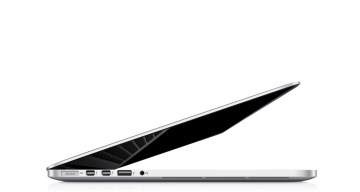The new MacBook Pro, announced at WWDC 2012, with an unprecedented 2,880 x 1,880 pixel display.
2009: The 13-inch MacBook Pro
When Apple’s Phil Schiller announced at WWDC 2009 that the 13-inch unibody MacBook would be adopted by the Pro family and become its entry-level model, no one’s jaw hit the floor, but the 13-inch MacBook Pro would go on to become Apple’s bestselling MacBook laptop.
[youtube=http://www.youtube.com/watch?v=OF1PWAVr9ao]
For starters, it was capable of six to seven hours of battery life, just like the updated 15-inch model — two to three hours better than the prior MacBook Pro models. To give it the “Pro” moniker, Apple added support for up to 8GB of memory, a Firewire port, an SD card slot, a much-improved LED-backlit 1280 x 800 screen, a backlit keyboard, higher-end processor and hard drive options (including solid state), all while bringing the baseline price in at about $100 below the prior version.
2010-2011: New Cores, AMD GPUs and Thunderbolt
Since the 13-inch MacBook Pro’s announcement at WWDC 2009, subsequent MacBook Pro changes have been subsurface.
In April 2010, Apple added Intel’s Core i5 and i7 CPUs to the 15- and 17-inch models and included a higher-resolution display option (1680 x 1050) on the 15-inch model. Battery life improvements (and size) allowed the 13-inch model to squeeze out a few more hours of use, climbing as high as eight hours in real world tests (Apple claimed up to 10).
In February 2011, Apple added Intel’s Thunderbolt technology as well as quad-core Sandy Bridge processors and an HD FaceTime camera (720p) to the Pros. After years of problems with Nvidia GPUs (including a product recall for “a higher than normal failure rate … due to a packaging defect”), Apple switched to discrete AMD graphics processors, offering integrated Intel HD graphics for day-to-day use (Intel HD graphics came integrated with the Core i5 and i7 CPUs in April 2010) and GPUs in AMD’s Radeon HD 6000 series for 3D heavy-lifting.
The last MacBook Pro update prior to WWDC 2012 occurred on October 24, 2011 — a simple processor speed bump along with slightly faster AMD Radeon HD 6000 series GPUs.
2012: The “Next-Generation” MacBook Pro
“It’s thinner than my finger,” boasted Apple’s Phil Schiller at WWDC 2012, trotting out the company’s latest, greatest, arguably most dramatic laptop change-up since the MacBook Air.
At 0.71 inches thick, it’s basically the same as the 0.6-inch MacBook Air, and weighing 4.46 pounds, it’s only 1.5 pounds heavier than the 13-inch MacBook Air (and a full pound lighter than the late 2011 15-inch MacBook Pro — technically the lightest Pro ever made, though the late 2011 13-inch model was only fractionally heavier at 4.5 pounds).
How’d Apple do it? By eliminating the optical drive, for starters.
But the biggest head-turner is inarguably the new Pro’s 2,880 x 1,880 pixel display, making it the highest resolution laptop monitor (or high-definition TV, along with most desktop monitors) on the planet. “Reading your mail is like reading fine print,” bragged Schiller, adding that web browsing would be “magazine-like” on the display.

Apple
It’s not technically a “Retina” display, of course, since it tops out at 220 pixels per inch (even taking into account viewing distance), but that’s Apple’s marketing term for anything high-resolution these days, so we’re stuck with it (and besides, who wants to argue with over 5.1 million pixels?). The display is also said to have higher contrast ratios, better viewing angles and reduced glare (though it’s still a glossy screen, for better or worse).
The only downside of a screen size this advanced: Everything non-native has to be scaled, a process known as interpolation, which means applications not designed for the display’s native resolution could look less sharp or much too small for the 15.4-inch diagonal workspace.
In terms of processing headroom, the new system can be configured with a 2.3 GHz, 2.6 GHz or 2.7 GHz Intel Core i7 processor (with turbo boosting up to 3.3 GHz, 3.6 GHz or 3.7 GHz, respectively). It ships with 8GB of memory default (up to 16GB configurable), a 256GB flash drive (up to 768GB configurable), a 720p FaceTime camera, 802.11n Wi-Fi, Bluetooth 4.0, uses Intel’s HD 4000 GPU for day-to-day video and includes an Nvidia GeForce 650M for 3D-intense stuff (Schiller demoed Diablo III running smoothly on the system).
It has a full-sized backlit keyboard, two USB 3.0 ports, an SDXC card slot, a dedicated HDMI port, two Thunderbolt ports, a headphone port, a thinner MagSafe connection and Apple’s claiming battery life of up to seven hours.
Apple also updated its older-style 13- and 15-inch MacBook Pros at WWDC 2012, offering processing speed and memory bumps while maintaining the older unibody chassis and standard-resolution screens for substantially less money than the company’s asking for the next-gen Pro.
Conspicuously absent from the revised MacBook Pro lineup? The 17-inch model. Requiescat in pace? We’ll see. Apple hasn’t quite confirmed it’s out for good, but its absence from the Apple Store speaks volumes. Also up in the air: whether the company will eventually offer a lighter weight 13-inch Pro, with a screen to match the 15-inch model’s groundbreaking new one.
MORE: Photos from Apple’s 2012 Worldwide Developers Conference Keynote

